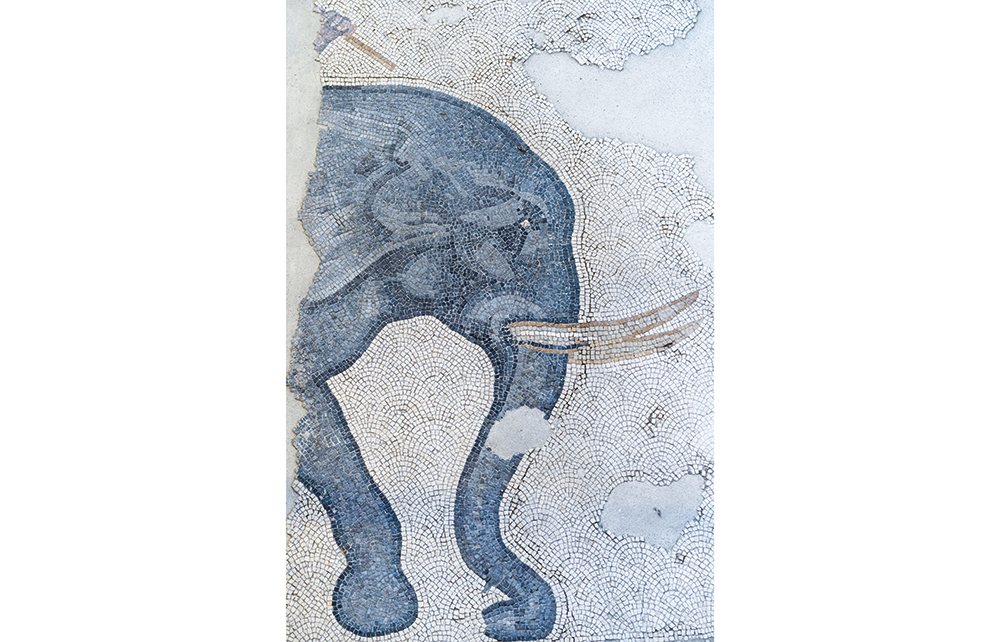Did you know that the elephant was the most written about animal in the Roman world? Pyrrhus of Epirus, of victory fame, was the first to introduce it to Italy as an engine of war when he invaded in 280 BC. Roman soldiers could not decide whether it was an animal or a machine. Eventually they plumped for luca bos (‘Lucanian cow’), though the creatures came from India rather than Italian Lucania and were more inclined to trumpet than moo.
And did you know that the people of Roman Cyrene in Libya were legally obliged to declare war on locusts three times a year? The swarms were so deadly that inhabitants had to employ a three-staged attack. The eggs were killed first, then the grubs, and finally the mature insects. The people of Lemnos were similarly tasked with delivering dead locusts to their magistrates each year.
And did you know that the largest pigeons in Italy came from Campania in the south? Or that black-haired dogs were considered the most intimidating and therefore most effective guard dogs in Rome? Or that the hooves of Julius Caesar’s beloved horse Genitor were purportedly cloven in such a way as to resemble toes?
Battle Elephants and Flaming Foxes is a ‘Did You Know?’ kind of a book. It is not quite a bestiary, although the first part is described as ‘a bit of’ one. Nor is it a fluid account of animals in the Roman world in the manner of Pliny’s Natural History. It is more of a commonplace book – a jumble of intriguing quotations and snippets arranged by animal – followed by chapters on chariot racing and the place of animals in medicine, fashion and the army, as pets and, shudder, meat.
It’s all very chatty and informal. A paragraph on Hannibal’s use of elephants in the Punic Wars breaks off into bullet points: ‘Here are some Hannibal facts.’ A long quotation from Plutarch on the preparation of pork on spits and the trampling of piglets in the womb to create thicker cuts of meat prompts a sympathetic interjection from Caroline Freeman-Cuerden: ‘Blimey, I might have to go and cuddle a pig.’ An English teacher with a background in classics, she is a self-confessed animal lover. One can almost see her tears on the page when she describes the Romans’ cruelty to dolphins, lions and horses.
The brutes were wholly unfamiliar with the concept of animal rights. They even mistreated elephants, in spite of coming to believe that they were the closest things to humans in the animal world. It was its size and spiritual similarity to man, as Italo Calvino once put it, that earned the elephant such an important place in classical literature. Pliny was convinced that it was just like us: intelligent, literate (insofar as it could be taught to memorise the Greek alphabet) and governed by ‘a desire for love and glory’. All the same, a willingness to beat and hunt elephants was perhaps only to be expected from a people who fed each other to lions. Aksum, near modern-day Eritrea, became a prime supplier of ivory for Roman sword hilts and dice.
Life could be hard for frogs. They were boiled to make hair-removal cream
as well as toothpaste
Life in ancient times could be even harder for frogs. They were boiled to make hair-removal cream as well as toothpaste. And beavers had constantly to watch their backs. Romans liked to extract juices from the scent glands located near their anal passages and use them to make remedies to treat cramp, sciatica and scorpion bites. The efficacy of these concoctions – this book reproduces many recipes – was seldom disputed.
The joy of leafing through a commonplace book lies in the uncertainty of what you may find, since such books tend to be devoid of intelligible order and design. This one retains that element of surprise and fun through its haphazard arrangement, but with all its sub-headings and bullet points it veers more towards a user-friendly textbook than a John Julius Norwich-style Christmas cracker. This is not a criticism except insofar as the textbook model can inspire some grating classroom language – ‘This sounds pretty dangerous to me’; ‘I told you that the Roman general Pompey had a bit of trouble with elephants. Well, here’s an example.’
The cornucopia of stories and anecdotes, drawn from both poetry and prose, is nonetheless lovely. A favourite, from Columella’s De Re Rustica, describes the vanity that comes over mares if they glimpse their reflection in water: ‘They are captured by mad love, and because of this they forget their pasture, waste away in longing and die.’ But the spell could be broken by giving the mare a bad haircut and leading her back to the water. If she could not be made to drink, she could be made to stare at her own ugliness until she forgot the beautiful animal she had seen before. Too cruel.






Comments